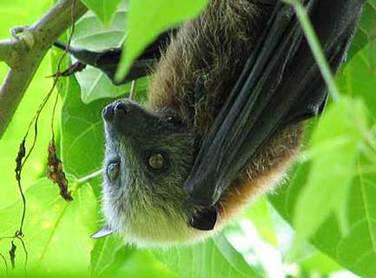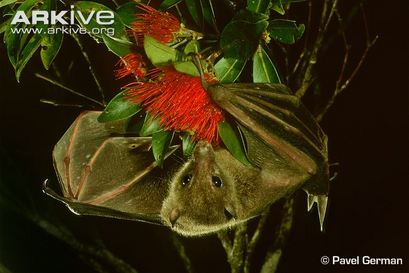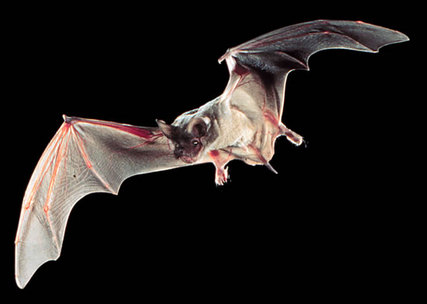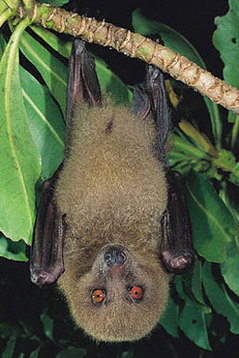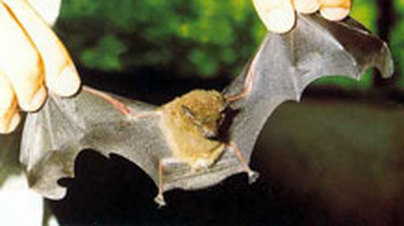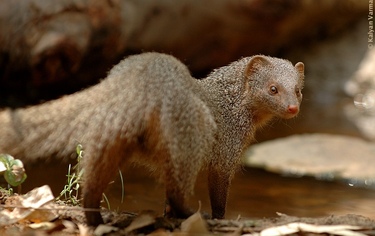MAMMALS
Samoan Flying Fox [Pteropus samoensis]
Status: Threatened
The Samoan Flying Fox is a species of fruit bat that is a megabat and not endemic to the island of Fiji. According to the IUCN, the Samoan Flying Fox is listed as Near Threatened because it is still relatively widely distributed, and numbers do not appear to be declining fast enough to qualify for a threatened category. The Samoan Flying Fox is restricted to Fiji, Samoa, and American Samoa. In Fiji it is known from the islands of Vatu Vara, Cicia, Vanua Balavu, Kadavu, Ovalau, Taveuni, Vanua Levu, Viti Levu, and probably occurs on some medium-sized islands in the Lau Group (Palmeirim et al. 2005).
Unlike most other pteropodids, this species roosts alone or in small family groups; most often in the forest canopy. The females are believed to give birth to a single young annually. In Fiji, the hunting of this species is only for local consumption and is not a major threat to the species, particularly on large islands (Palmeirim et al. 2005).
However, if Fijians either begin to hunt flying foxes with guns or to collect for trade the threat of overexploitation could become serious (Palmeirim et al. 2005). Populations throughout the range of this species are susceptible to typhoons and other storm events (Mickleburgh et al. 1992; Flannery 1995).
The Samoan Flying Fox is a species of fruit bat that is a megabat and not endemic to the island of Fiji. According to the IUCN, the Samoan Flying Fox is listed as Near Threatened because it is still relatively widely distributed, and numbers do not appear to be declining fast enough to qualify for a threatened category. The Samoan Flying Fox is restricted to Fiji, Samoa, and American Samoa. In Fiji it is known from the islands of Vatu Vara, Cicia, Vanua Balavu, Kadavu, Ovalau, Taveuni, Vanua Levu, Viti Levu, and probably occurs on some medium-sized islands in the Lau Group (Palmeirim et al. 2005).
Unlike most other pteropodids, this species roosts alone or in small family groups; most often in the forest canopy. The females are believed to give birth to a single young annually. In Fiji, the hunting of this species is only for local consumption and is not a major threat to the species, particularly on large islands (Palmeirim et al. 2005).
However, if Fijians either begin to hunt flying foxes with guns or to collect for trade the threat of overexploitation could become serious (Palmeirim et al. 2005). Populations throughout the range of this species are susceptible to typhoons and other storm events (Mickleburgh et al. 1992; Flannery 1995).
Fijian Blossom Bat [Notopteris macdonaldi]
Status: Vulnerable
The Fijian Blossom bat is found in both Fiji and Vanuatu; however, it is suspected that more than half of the global total lives in Fiji. While it is present on Fiji's three main islands, there are only four known roosting sites (breeding caves) in Viti Levu, which can hold 200-2,000 individuals. They are likely not present on many small and medium sized islands.
The Fijian Blossom bat has an elongated muzzle and a long free tail. Although they are fruit bats, the The Fijian Blossom bats prefer to eat nectar and pollen over fruit, providing a vital function of pollinating the forests. As a result of this diet, the species can be found foraging in a variety of different altitudes, depending on the season. The species has been spotted foraging mostly mostly in lowland forest, montane forests and in intermediate altitudes, but it has also been spotted in lowland secondary forest, rural gardens, and high altitudes.
The Fijian Blossom bat is listed as vulnerable by the IUCN. Because it is only concentrated in four known roosts, it makes each roost particularly assailable. In the cave on the Eastern half of the island, the colony of Fijian Blossom Bats is less populated than those on the western side of the island. This is likely because the East side has less native forest, which was cut down in place of sugar can plantations and pastureland. Another threat is harvesting for human consumption. Armed with shotguns, the large numbers of roosting bats makes an easy target for humans to kill and eat, although they are mostly killed only on special occasions. Perhaps a more immediate threat is increasing tourist levels; half of the roosting caves are opened to tourists, who make noise, shine lights and other forms of disturbance. This might lead to abandonment.
The Fijian Blossom bat is found in both Fiji and Vanuatu; however, it is suspected that more than half of the global total lives in Fiji. While it is present on Fiji's three main islands, there are only four known roosting sites (breeding caves) in Viti Levu, which can hold 200-2,000 individuals. They are likely not present on many small and medium sized islands.
The Fijian Blossom bat has an elongated muzzle and a long free tail. Although they are fruit bats, the The Fijian Blossom bats prefer to eat nectar and pollen over fruit, providing a vital function of pollinating the forests. As a result of this diet, the species can be found foraging in a variety of different altitudes, depending on the season. The species has been spotted foraging mostly mostly in lowland forest, montane forests and in intermediate altitudes, but it has also been spotted in lowland secondary forest, rural gardens, and high altitudes.
The Fijian Blossom bat is listed as vulnerable by the IUCN. Because it is only concentrated in four known roosts, it makes each roost particularly assailable. In the cave on the Eastern half of the island, the colony of Fijian Blossom Bats is less populated than those on the western side of the island. This is likely because the East side has less native forest, which was cut down in place of sugar can plantations and pastureland. Another threat is harvesting for human consumption. Armed with shotguns, the large numbers of roosting bats makes an easy target for humans to kill and eat, although they are mostly killed only on special occasions. Perhaps a more immediate threat is increasing tourist levels; half of the roosting caves are opened to tourists, who make noise, shine lights and other forms of disturbance. This might lead to abandonment.
Fijian Free-tailed Bat [Tadarida bregullae]
Status: Endangered
The Fijian Free-tailed bat is nearly endemic to Fiji; it is found only in Fiji and the island nation of Vanuatu. However, the populations in both areas are very restricted. In Vanuatu, the Fijian Free-tailed bat only exists on two islands, as is the case in Fiji, with populations recorded on the islands of Taveuni and Vanua Levu.
The Fijian Free-tailed bat is a powerful flyer, foraging widely over forest, farmland, and even the ocean. They are capable of foraging more than 30km away from roosts and flying several hundred kilometers in a single night.
Researchers only know of one roosting cave for the Fijian population, owned by locals near Nakancagi in Vanua Levu. There, researchers found a few thousand bats roosting. However, local people might be threatening the Fijian-Free tailed bat. The locals installed a water collection system inside the cave, which might be disturbing the bats. Another concern is the over-harvesting of the Fijian Free-tailed bat by people, who use them as a source of food, although the amount of disturbance is unknown. Another potential issue is that of the forest surrounding the single mud stone cave. While it is unknown if the bats use the forest for forraging, the forest is an important temperature and humidity stabilizer. A change in these levels, via humans cutting down the trees, might make the cave unsuitable for the bats. The removal of trees will also affect the tall tree forest cover, which prevents light from reaching the ground and thus prevents shrubs from growing around the cave entrance and potentially making the roosting site impassable.
The Fijian Free-tailed bat is nearly endemic to Fiji; it is found only in Fiji and the island nation of Vanuatu. However, the populations in both areas are very restricted. In Vanuatu, the Fijian Free-tailed bat only exists on two islands, as is the case in Fiji, with populations recorded on the islands of Taveuni and Vanua Levu.
The Fijian Free-tailed bat is a powerful flyer, foraging widely over forest, farmland, and even the ocean. They are capable of foraging more than 30km away from roosts and flying several hundred kilometers in a single night.
Researchers only know of one roosting cave for the Fijian population, owned by locals near Nakancagi in Vanua Levu. There, researchers found a few thousand bats roosting. However, local people might be threatening the Fijian-Free tailed bat. The locals installed a water collection system inside the cave, which might be disturbing the bats. Another concern is the over-harvesting of the Fijian Free-tailed bat by people, who use them as a source of food, although the amount of disturbance is unknown. Another potential issue is that of the forest surrounding the single mud stone cave. While it is unknown if the bats use the forest for forraging, the forest is an important temperature and humidity stabilizer. A change in these levels, via humans cutting down the trees, might make the cave unsuitable for the bats. The removal of trees will also affect the tall tree forest cover, which prevents light from reaching the ground and thus prevents shrubs from growing around the cave entrance and potentially making the roosting site impassable.
Fijian Monkey-Faced Bat [Mirimiri acrodonta]
Status: Critically Endangered
The Fijian Monkey-Faced Bat, also known as the Fiji flying fox, is a megabat endemic to Fiji, and is Fiji’s only endemic mammal. This species has recently been placed in its own genus, Mirimiri (Helgen 2005). It was previously considered to belong to Pteralopex. Few specimens have been captured. Population size unknown, but is found in a very restricted range. Likely a few hundred individuals (under 1,000). It is unknown if there is specific threats to the species at present, but because of its specialized niche habitat destruction is a possible major threat. According to the IUCN, the Fijian Monkey Faced Bat is critically endangered.
The Fijian Monkey-Faced Bat, also known as the Fiji flying fox, is a megabat endemic to Fiji, and is Fiji’s only endemic mammal. This species has recently been placed in its own genus, Mirimiri (Helgen 2005). It was previously considered to belong to Pteralopex. Few specimens have been captured. Population size unknown, but is found in a very restricted range. Likely a few hundred individuals (under 1,000). It is unknown if there is specific threats to the species at present, but because of its specialized niche habitat destruction is a possible major threat. According to the IUCN, the Fijian Monkey Faced Bat is critically endangered.
Pacific Sheath-tailed Bat [Emballonura semicaudata]
Status: Endangered
The Pacific Sheath-tailed bat is native to Fiji as well as other areas in the Pacific. Scholars have estimated that Fiji likely contains the largest population of subspecies E.s Semicaudata. However, its populations are declining among Fiji's medium and smaller sized islands, and while it used be exist in prominent numbers on Fiji's largest island, Viti Levu, it is now thought to be extinct.
This small bat is usually found roosting in caves, but it can also be found hanging on cliff sides, in rock depressions or in lava tubes. The Pacific Sheath-tailed bat displays sexual dimorphism, with females typically being larger than their male counterparts. Both sexes have brown fur and a very small tail. Pacific Sheath-tailed bats are insectivores and are mostly dependent on forests to provide food, but they have been seen occasionally hunting in village areas.
The Pacific Sheath-tailed bat is currently endangered. While more studies are needed, scholars have hypothesized about the causes of the Pacific Sheath-tailed bats' decline. One possible explanation is that of predation. Fiji's domestic and ferral cat population have increased recently, which can be very effective at stalking and killing bats. Another introduced predator is the Indian Mongoose, albeit to a lesser extent than the cats. Another possible explanation is the increasing use of pesticides, which might both reduce the bats' food source and lead to possible poisoning. Deforestation is another potential threat, where burning near roosts and the actual destruction of the forest ecosystem might cause reduced populations.
The Pacific Sheath-tailed bat is native to Fiji as well as other areas in the Pacific. Scholars have estimated that Fiji likely contains the largest population of subspecies E.s Semicaudata. However, its populations are declining among Fiji's medium and smaller sized islands, and while it used be exist in prominent numbers on Fiji's largest island, Viti Levu, it is now thought to be extinct.
This small bat is usually found roosting in caves, but it can also be found hanging on cliff sides, in rock depressions or in lava tubes. The Pacific Sheath-tailed bat displays sexual dimorphism, with females typically being larger than their male counterparts. Both sexes have brown fur and a very small tail. Pacific Sheath-tailed bats are insectivores and are mostly dependent on forests to provide food, but they have been seen occasionally hunting in village areas.
The Pacific Sheath-tailed bat is currently endangered. While more studies are needed, scholars have hypothesized about the causes of the Pacific Sheath-tailed bats' decline. One possible explanation is that of predation. Fiji's domestic and ferral cat population have increased recently, which can be very effective at stalking and killing bats. Another introduced predator is the Indian Mongoose, albeit to a lesser extent than the cats. Another possible explanation is the increasing use of pesticides, which might both reduce the bats' food source and lead to possible poisoning. Deforestation is another potential threat, where burning near roosts and the actual destruction of the forest ecosystem might cause reduced populations.
Small Asian Mongoose [Herpestes javanicus]
Status: Least Concern
The Small Asian Mongoose or the Javan Mongoose is not endemic to the Fijian Islands, but was introduced in hopes of controlling the rodent population. Mongeese are considered an invasive species, as they have killed many native island species. The body of the Javan Mongoose is slender, with an elongated head and pointed snout. The IUCN has designated this species as “least concerned,” because its wide distribution, presumed large population, and it is unlikely it will decline at a fast rate. The IUCN lists the Small Asian Mongoose as one of the world’s 100 worst invasive alien species (Lowe et al. 2000). This species is terrestrial, seldom climbing trees and feeds, during both the day and the night, on a wide diet, which includes rats, birds, reptiles, frogs, crabs, insects, and even scorpions (Lekagul and McNeely 1977).
The Small Asian Mongoose or the Javan Mongoose is not endemic to the Fijian Islands, but was introduced in hopes of controlling the rodent population. Mongeese are considered an invasive species, as they have killed many native island species. The body of the Javan Mongoose is slender, with an elongated head and pointed snout. The IUCN has designated this species as “least concerned,” because its wide distribution, presumed large population, and it is unlikely it will decline at a fast rate. The IUCN lists the Small Asian Mongoose as one of the world’s 100 worst invasive alien species (Lowe et al. 2000). This species is terrestrial, seldom climbing trees and feeds, during both the day and the night, on a wide diet, which includes rats, birds, reptiles, frogs, crabs, insects, and even scorpions (Lekagul and McNeely 1977).
Back to the Top
Sources
Brooke, A. & Wiles, G. 2008. Pteropus samoensis. In: IUCN 2010. IUCN Red List of Threatened Species. Version 2010.4. <www.iucnredlist.org>. Downloaded on 16 May 2011.
Helgen, K., Palmeirim, J. & Allison, A. 2008. Mirimiri acrodonta. In: IUCN 2010. IUCN Red List of Threatened Species. Version 2010.4. <www.iucnredlist.org>. Downloaded on 16 May 2011.
Wozencraft, C., Duckworth, J.W., Choudury, A., Muddapa, D., Yonzon, P., Kanchanasaka, B., Jennings A. & Veron, G. 2008. Herpestes javanicus. In: IUCN 2010. IUCN Red List of Threatened Species. Version 2010.4. <www.iucnredlist.org>. Downloaded on 16 May 2011.
Distribution, Status, and Conservation of Bats in the Fiji Island, Champion, A.,Dunn, T., Fisher, M., Naikatina, A., Palmeirim, J., Niukula, Thorsteinsdottir, S., J., Tuiwawa, M., Qalovaki, S., Yabaki-Grounder, M. <http://www.sprep.org/bats/pdfs/FijiBatsFullReport.pdf> Downloaded 22 May 2011.
Brooke, A. & Wiles, G. 2008. Pteropus samoensis. In: IUCN 2010. IUCN Red List of Threatened Species. Version 2010.4. <www.iucnredlist.org>. Downloaded on 16 May 2011.
Helgen, K., Palmeirim, J. & Allison, A. 2008. Mirimiri acrodonta. In: IUCN 2010. IUCN Red List of Threatened Species. Version 2010.4. <www.iucnredlist.org>. Downloaded on 16 May 2011.
Wozencraft, C., Duckworth, J.W., Choudury, A., Muddapa, D., Yonzon, P., Kanchanasaka, B., Jennings A. & Veron, G. 2008. Herpestes javanicus. In: IUCN 2010. IUCN Red List of Threatened Species. Version 2010.4. <www.iucnredlist.org>. Downloaded on 16 May 2011.
Distribution, Status, and Conservation of Bats in the Fiji Island, Champion, A.,Dunn, T., Fisher, M., Naikatina, A., Palmeirim, J., Niukula, Thorsteinsdottir, S., J., Tuiwawa, M., Qalovaki, S., Yabaki-Grounder, M. <http://www.sprep.org/bats/pdfs/FijiBatsFullReport.pdf> Downloaded 22 May 2011.
